
Calystegia is a genus of about 25 species of flowering plants in the bindweed family Convolvulaceae. The genus has a cosmopolitan distribution in temperate and subtropical regions, but with half of the species endemic to California. They are annual or herbaceous perennial twining vines growing 1–5 m tall, with spirally arranged leaves. The flowers are trumpet-shaped, 3–10 cm diameter, white or pink, with a sometimes inflated basal epicalyx.

Fremontodendron, with the common names fremontia and flannelbush or flannel bush, is a genus of three known species of shrubs native to the Southwestern United States and northwest Mexico.

Fremontodendron californicum, with the common names California flannelbush, California fremontia, and flannel bush, is a flowering shrub native to diverse habitats in southwestern North America.
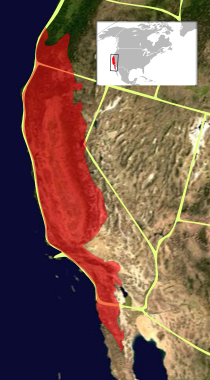
The California Floristic Province (CFP) is a floristic province with a Mediterranean-type climate located on the Pacific Coast of North America with a distinctive flora similar to other regions with a winter rainfall and summer drought climate like the Mediterranean Basin. This biodiversity hotspot is known for being the home of the Sierran giant sequoia tree and its close relative the coast redwood. In 1996, the Province was designated as a biodiversity hotspot allowing it to join ranks among 33 other areas in the world with many endemic species. To be named a biodiversity hotspot, an area has to contain species and plant life that cannot be found anywhere else in the world. The California Floristic Province is home to over 3,000 species of vascular plants, 60% of which are endemic to the province.

Nolina cismontana, the chaparral beargrass, chaparral nolina, California beargrass, Peninsular beargrass, or peninsular nolina, is a rare species of flowering plant of the Peninsular and Transverse Ranges in California. It is endemic to only four counties in Southern California: Los Angeles, Orange, San Diego and Ventura Counties. There are perhaps 15 to 17 occurrences in existence, with a total population estimated between 10,000 and 20,000.
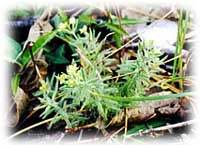
Galium californicum is a species of flowering plant in the coffee family known by the common name California bedstraw.

Arctostaphylos myrtifolia is a rare species of manzanita known by the common name Ione manzanita. It is endemic to the Sierra Nevada foothills of California. It grows in the chaparral and woodland plant community on a distinctive acidic soil series in western Amador and Calaveras Counties. There are only about 17 occurrences, but the plant is abundant in some areas of its limited range. This is a federally listed threatened species.

Astragalus brauntonii is a rare species of milkvetch known by the common name Braunton's milkvetch. It is endemic to California, where it is known from fewer than 20 extant occurrences in the hills and mountains surrounding the Los Angeles Basin in Southern California. This is a federally listed endangered species in the United States.
The Red Hills are a mountain range in Tuolumne County, California. Elevations within the Red Hills vary between 750 and 1,750 feet above sea level. Slopes of the hills themselves vary from about 30% to 75%.

Calystegia occidentalis is a species of morning glory known by the common names Modoc morning glory or chaparral false bindweed.
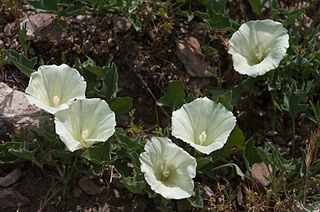
Calystegia subacaulis is a species of morning glory known by the common name hillside false bindweed.

Ceanothus ferrisiae is a rare species of shrub in the family Rhamnaceae. Its common name is coyote ceanothus.

Ceanothus roderickii is a rare species of shrub in the family Rhamnaceae known by the common name Pine Hill ceanothus. It is endemic to western El Dorado County, California, where it grows in the chaparral and woodlands of the Sierra Nevada foothills, such as the Pine Hill Ecological Reserve. It is named after 20th century California flora explorer, botanist, and arboretum director Wayne Roderick.
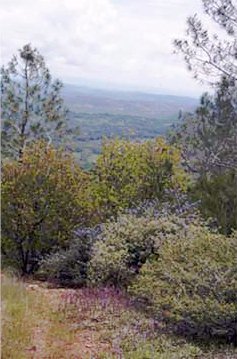
Pine Hill Ecological Reserve is a nature reserve of 403 acres (1.63 km2) located due east of Folsom Lake in the Sierra Nevada foothills, in El Dorado County, California. The reserve was established in 1979, and is managed by the Bureau of Land Management.

Lomatium stebbinsii, known by the common name Stebbins' desertparsley, is a rare species of flowering plant in the carrot family.

Harmonia stebbinsii is a species of flowering plant in the family Asteraceae known by the common name Stebbins' tarweed, or Stebbins' madia. It is endemic to northern California, where it is limited to the Klamath Mountains and adjacent slopes of the North Coast Ranges. It is a member of the serpentine soils plant community in these mountains, found at elevations of 1100–1600 meters. It is a rare annual herb producing a bristly stem up to about 25 centimeters tall studded with black resin glands. Its bristly leaves grow up to about 2 centimeters long and are mostly gathered near the base of the plant. The inflorescence is an array of flower heads lined with hairy, glandular, purple-tipped phyllaries. The head has a few yellow ray florets several millimeters long and yellow disc florets. The fruit is an achene tipped with a pappus.
Monardella stebbinsii is a rare species of flowering plant in the mint family known by the common names Feather River monardella and Stebbins' monardella. It is endemic to Plumas County, California, where it is known from only about ten occurrences along the North Fork of the Feather River in the High Sierra. It is a member of the serpentine soils flora in rocky mountain habitat.
Packera ganderi is a rare species of flowering plant in the aster family known by the common name Gander's ragwort. It is endemic to southern California, where it is known from a few occurrences in San Diego and Riverside Counties.
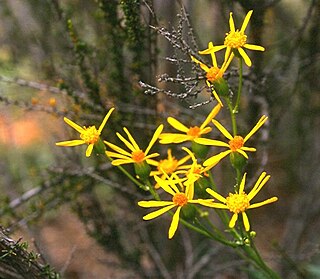
Packera layneae, known by the common name Layne's ragwort and Layne's butterweed, is a rare species of flowering plant in the aster family.
Agnorhiza bolanderi is a species of flowering plant known by the common name Bolander's mule's ears. It is endemic to California, where it is known only from a narrow section of the Sierra Nevada foothills about 275 kilometers long from Shasta County to Mariposa County. It grows in chaparral and grassland habitat, usually on serpentine soils.


















